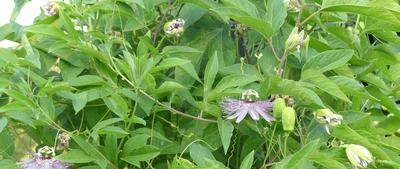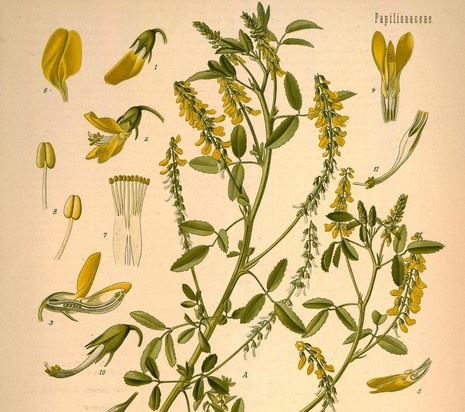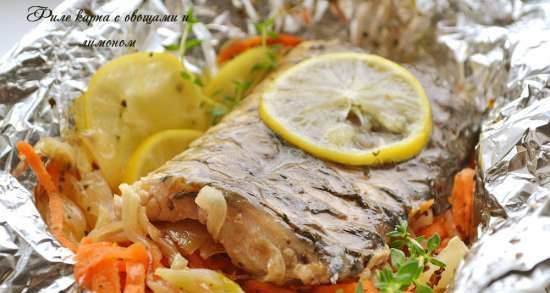|
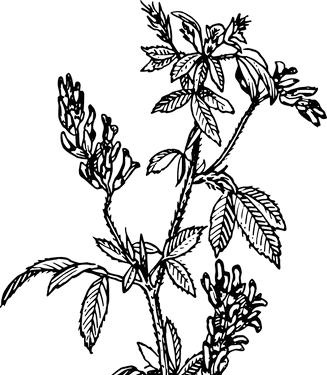 Alfalfa! Queen of herbs of the planet. This is the opinion of the breeders. This plant has an almost ideal ratio of protein, fat and carbohydrates. Almost all the vitamins a four-legged needs. Almost twice as much protein as clover. And alfalfa grass dries twice as fast as any other. Alfalfa! Queen of herbs of the planet. This is the opinion of the breeders. This plant has an almost ideal ratio of protein, fat and carbohydrates. Almost all the vitamins a four-legged needs. Almost twice as much protein as clover. And alfalfa grass dries twice as fast as any other.
Yet this perfection has an Achilles heel that spoils its resounding fame as the best of herbs. Few seeds. The same minus as for clover, but the reasons are different. Although it's all about the flower here ...
The flower is cut according to the usual "pea" type for moths. Two fused petals - a boat, like two palms folded together. On the sides are two more petals, smaller and narrower, something like oars. Above, the largest petal resembles a sail. There is both nectar and pollen. The trouble with alfalfa is that the flowers are closed. They must be opened by a creature for which nectar and pollen are in store.
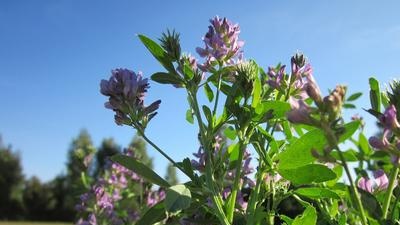
Nature has allocated a bee and a bumblebee for this purpose. Wild bee... The man added cultural, melliferous. All three work in different ways. The result is accordingly also different.
The wild bee sits down on the boat, squeezes the proboscis between the oars. The head rests against the sail. An effort! P-times! A column of stamens is released from the boat and slaps the bee on the belly. Seals the pollen. The operation is fast, thirty flowers per minute.
The bumblebee does the same thing more roughly. The whole flower will break. But pollination will do.
The domestic bee is a different matter. She does not spoil the flower, but it also gives almost no benefit. Pushes the proboscis between the boat and the sail. The nectar takes, but the flower does not open. And the stamens stay in place. And the pollen does not spill out. Grass-growers calculated that domestic bees pollinate an insignificant proportion of plants - less than one percent! Wild - almost a hundred! However, there are very few wild ones left. Nature did not expect that a person would begin to sow such a lot of alfalfa (Argentina alone - 7 million hectares) and hinder wild bees in their living space.
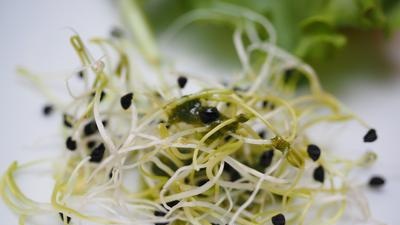
Is there a way out of the impasse? Canadian alfalfa fans have come up with the following. They recruited a leaf-cutting bee megahila to work. Megahillas live alone, but next door to each other. They settle in tree trunks, fences, roofs. There are still plenty of such places. The cells are not made of wax, but from the leaves of their ward alfalfa, a piece of the desired size is cut out. Roll up with a tube. It turns out a cell. Stuffed with honey. Seal with a lid, which is also cut from the alfalfa leaf. Canadians artificially breed leaf cutters. They make special hives for them and take them out to the fields when there is a need.
Of the sixty species of alfalfa scattered throughout the world, the most important is blue alfalfa, sown. With blue flowers. In addition to the lack of seeds, she has another drawback. The root goes into the soil like a radish. It grows a little to the sides. Therefore, it is not good for grazing. For haymaking only.
Another matter is yellow alfalfa. With yellow flowers. That is the opposite. Morozov is not afraid. Not afraid of grazing. There are hundreds of shoots in the bush! Although the disadvantage is the same: the lack of seeds.
There are, however, in this respectable genus, species where the seeds are not only not limited, but, on the contrary, intrusively climb into their own hands. And they don't know how to get rid of them. You don't have to go far for an example. In Crimea, a similar creature grows on the steppe slopes: the Crimean hawk - small alfalfa. Its name fully justifies. As tall as a matchbox. The lowered stems spread along the ground. If not for the yellow flowers, you might not even notice. However, four-legged animals look for a burr in the most inconceivable places and eat with pleasure. Especially sheep. Such sheep's love is very profitable for a hawk. Its snail-like, coiled beans are armed with curved thorns.They easily catch on sheep's wool and follow along with the passing transport. If the sheep lie down in the thickets of a bush to rest, then the barrels are already attached in a continuous mass. Try to remove them from the fur afterwards. No matter how ripped off, no matter how combed out, the residues get into the fabric and spoil it. Even rinsing does not help and the fabric becomes whitish.
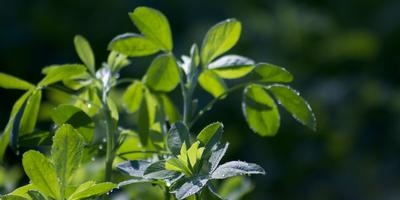
There are also several other types of the same creepers. Thanks to their tenacious beans, they even stopped in Australia. They dispersed there across the desert plains of the center and the west. With the help of the same sheep. Sheep wool is also spoiled, for which Australian farmers are nicknamed "grass lice". They say that "grass lice" have become an even greater disaster on this continent than prickly pear cacti. Sometimes, however, there is benefit from "lice". They are very nutritious and delicious. But because of the thorns, the sheep eat them only after the rains, when the thorns are wet and not dangerous. But the rains in the deserts are so rare ...
So, alfalfa has been feeding four-legged animals for hundreds of years. And although it seems like a simple grass, it is still not fully understood. Livestock breeders have recently discovered one very desirable property of it. The fact is that calves consume a lot of milk. Almost a quarter of the milk yield. We tried to replace some of the milk, but we could not find a good substitute. It was then that alfalfa came to mind. Squeezed juice from the grass. Compared to milk. Is very similar. There is no fiber harmful to calves. There are no other ballast substances either. But protein-protein up to forty percent (in milk only 27). The most important thing is that the acidity of the juice is the same as that of milk. You can mix without fear of curling. And scientists are thinking how to put alfalfa on the table to a person, bypassing a cow. Of course, for people this is still a distant sight. But for animals, the benefits of alfalfa are a proven fact. It energizes, strengthens muscles and bones. Chickens and turkeys lay more eggs. Sheep are getting fat. Particularly beneficial for horses. Softens the temper of foals. They stop kicking and kicking and behave like well-mannered youths.
True, in all this there should be strict control on the part of the owners. You can easily overdo it, as happened with the Cossack A. Grekov on the Don. He released his foals on alfalfa to improve their hot temper. I didn't bother to look after them, believing that the longer they stay there, the better. As a result, the poor horses' stomachs swelled from gluttony and they almost gave up their breath.
"What if grazing on a clover?" He asked the magazine.
“Clover is just as dangerous,” the editorial staff replied. “Sow something better: timothy or a fire. And that is not far from sin. "
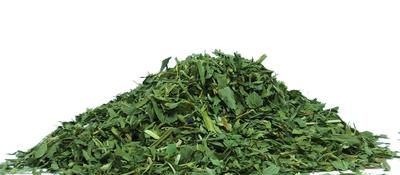
Recent events in the world have further spurred attention to alfalfa. When the energy crisis hit the Western world, the National Institute of Agronomy in France began to look for how to save energy in the production of fertilizers? The world spends more than one hundred million liters of oil every day on saltpeter alone. They began to compare different crops: which one requires more nitrogen fertilizers? Every year the French pour a bag of saltpeter for one hectare for wheat, and three times more for ryegrass. Alfalfa - zero! Here it is, the benefit!
It was not without reason that even people far from forage grasses admired alfalfa, and Mark Twain, who loved jokes so much, said: “Alfalfa is an ordinary herb, but with a higher education.”
A. Smirnov. Tops and roots
|
 Alfalfa! Queen of herbs of the planet. This is the opinion of the breeders. This plant has an almost ideal ratio of protein, fat and carbohydrates. Almost all the vitamins a four-legged needs. Almost twice as much protein as clover. And alfalfa grass dries twice as fast as any other.
Alfalfa! Queen of herbs of the planet. This is the opinion of the breeders. This plant has an almost ideal ratio of protein, fat and carbohydrates. Almost all the vitamins a four-legged needs. Almost twice as much protein as clover. And alfalfa grass dries twice as fast as any other.




